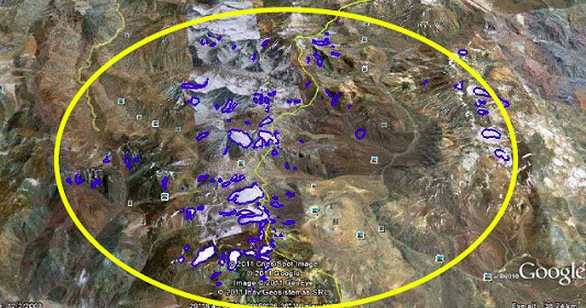Esta entrada también está disponible en: Spanish
November 25, 2014
While Barrick Gold’s lawyers and technical experts are busy in Chile working on structural design problems at the ill-fated Pascua Lama gold project, and while Barrick seeks renewed investment for the project, new accusations in Argentina point to identical environmental problems and foreseeable legal complications for the Canadian miner on the Argentine side of operations.
Barrick Gold now faces yet another complaint, this time filed before Argentine authorities, for the alleged bursting of permafrost environments from a tunnel several miles long, dug by Barrick through frozen ice-saturated and legally protected terrain. The allegations echo practically identical problems faced by the company in Chile, where more stringent environmental controls and a more environmentally conscious tribunal, has handed Barrick a court order closing down all operations at Pascua Lama, for being unable to contain acid drainage from frozen terrain at the foot of a heavily glaciated area of the project. The problem for Barrick however, will inevitably be Argentina’s legal framework, which unlike Chile specifically prohibits mining in glacier and permafrost areas.
Romina Picolotti, former Environment Secretary of Argentina and now President of the environmental policy organization, the Center for Human Rights and Environment (CEDHA), presented the complaint to Argentina’s National Public Defender’s Office, pointing to evidence surfacing in San Juan Province in Argentina, alleging that Barrick Gold’s tunnel has perforated legally protected ice-saturated permafrost environments.
“We’re not surprised of the news about the impacts of the tunnel to water resources. It’s the same project, in the same mountain, at the same site … there simply happens to be a political border dividing Argentina from Chile right through the middle” says Picolotti. “If the Chilean Environment Ministry and the court recognize that Barrick is destroying glaciers and permafrost on Chilean territory, it goes without saying that the same thing is likely happening in Argentina, since it is essentially the same glacial and periglacial environments,” adds Picolotti.
According to local sources in San Juan, as the summer months set in and as the frozen discontinuous permafrost begins to melt at and around Pascua Lama, the deeply dug tunnel spews out an uncontrollable amount of water, which picks up acidity as it comes into contact with newly exposed rock at the project site. Technical observers that have visited the tunnel site claim that this water flow is producing acid drainage. Silvia Villalonga, director of the local environmental NGO “FuCI” (Fundación Ciudadanos Independientes) in San Juan Argentina, recently filed a complaint to local provincial authorities against Pascua Lama, asking that the project be inspected by environmental authorities and that the acidic contamination be stopped immediately before it irreversibly contaminates rivers below.
“The tunnel was constructed in rock glacier and permafrost areas, and these have been impacted and are causing a large flow of water which must be neutralized with lime to lower the pH so that other waterways are not contaminated”, states Villalonga in FuCI’s complaint, which CEDHA also submitted to the National Public Defender’s Office as accompanying evidence.
Romina Picolotti, who served as Argentina’s Environment Secretary from 2006 to 2008, under two consecutive administrations, had at the time publicly expressed her concern over Pascua Lama. Her worries echoed those of Argentina’s National Park Authority who manages the UNESCO protected site where the Pascua Lama project is situated, the San Guillermo Biosphere Reserve. The park authorities had already raised a flag against Barrick’s mining practices in the area when they destroyed sensitive high mountain wetland ecosystems called “vegas” at their other project, Veladero.
Picolotti resigned in late 2008 when President Cristina Fernandez vetoed an earlier version of Argentina’s Glacier Protection Law, which was unanimously supported by Congress but downstruck by the President. The veto is now infamously referred to as “the Barrick Veto” with the public supposition that the Presidential decision to veto the law followed a call by Barrick’s highest management. But despite Barrick’s efforts to fight the glacier law in Argentine courts, the law returned in 2010, placing Pascua Lama in direct conflict with Argentina’s glacier legislation.
In the midst of seemingly endless green tape for Barrick’s Pascua Lama project in Chile, the future bodes even more complicated in Argentina as environmental groups begin to reveal the project’s glacier vulnerabilities.
Link to the complaint filed to the Public Defender’s Office (in Spanish) – https://center-hre.org/wp-content/uploads/2014/11/denuncia-CEDHA-defensor-del-pueblo.pdf
Link to CEDHA’s Report “Barrick’s Glaciers” https://center-hre.org/?p=13135&lang=en
For more Information:
[email protected]; +54 9 351 507 8376

